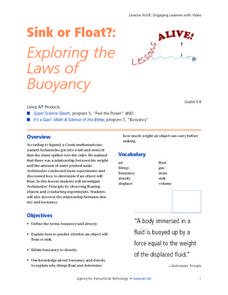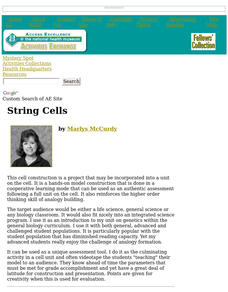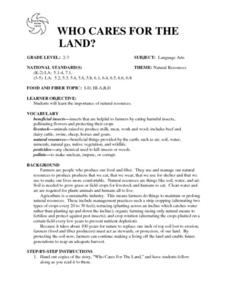Curated OER
Exploring Meteorite Mysteries: Building Blocks of Planets
Students simulate the formation of chondrites and asteroids. In this astronomy lesson, students demonstrate accretion using balloons and static electricity. They compare and contrast their models to the actual process of chondrites and...
Curated OER
Chemical Change
Fifth graders watch a demonstration in which a balloon is inflated using the gas created by combining vinegar and baking soda. Then, in groups, they combine various assigned substances and watch and record the results.
Curated OER
Payload Rocket
Students continue their examination of how to make a human presence in space. Using Newton's Laws of Motion, they discover the difference a rocket's payload affects the launch of a rocket. They develop a balloon rocket and test its...
Curated OER
Density Phenomena-Using the Concept of Density
Learners investigate the concept of density by observing demonstrations. In this density lesson plan, students make observations while the teacher demonstrates the Cartesian diver, a density column, a candle trough, a wave bottle, an...
Curated OER
Sink or Float: Exploring the Laws of Buoyancy
Middle schoolers explore the relationship between density and buoyancy. After watching a video explaining buoyancy, students discuss displacement and floating. Middle schoolers have a raft building competition. Afterward, they conduct...
Curated OER
The Magic of Static
Students investigate static electricity. In this physics lesson, students participate in an experiment with balloons to demonstrate how static electricity works.
Curated OER
Air Density and Temperature
Students investigate the effect of temperature on the density of air by putting an uncovered bottle in a bucket of hot water. Then they place a balloon over the mouth of the bottle. They repeat the procedure using ice water and explain...
Virginia Department of Education
Atomic Structure: Elements
It's all relevant, really. Individuals use the scientific method to learn more about elements, atoms, and their placement on the periodic table. They conduct experiments using materials common in nature to explore how elements affect our...
Curated OER
Journal of the Stars
Students receive balloons representing the "Life Cycle of the Stars." As the attached script is read, students follow the directions for the color of balloon they are given. Students chart the results for their star. They plot data from...
Virginia Department of Education
The Ratio of Surface Area to Volume
Demonstrate the ratio of surface area to volume in your high school class by using phenolphthalein, gelatin, and an onion. Intrigue the class by leading a discussion on osmosis and diffusion, then making "scientific jello." Participants...
Curated OER
States of Matter
Although the title is States of Matter, this presentation is a collection of 4 slides just dealing with gas particle behavior, pressure and the Laws of Boyles and Charles and Gay-Lussac.
Peace Corps
Celebrating Our Connections Through Water
Water is vital for survival, but how does it help global cultures flourish? Elementary and middle schoolers learn about the different cultures around the world that celebrate water and incorporate it into their festivals or traditions.
Curated OER
Build Your Own Hovercraft
Learners construct a hovercraft following specific procedures. In this technology lesson plan, students explain the physics principles behind hovercraft. They compare and contrast this machine with the aircraft.
Curated OER
Gas Law Homework Problem Set
In this chemistry worksheet, students determine the mass of the gas when filling a bicycle tire with nitrogen. Then they determine the volume of a balloon when at specific altitudes. Students also determine the partial pressure of oxygen...
Curated OER
Molecules in Motion
In this molecules instructional activity, students review how temperature and pressure affects molecule density. Students compare the volume of a balloon as temperature changes. This instructional activity has 9 fill in the blank, 8 true...
Curated OER
Weathering Rocks
Here is a geology lesson that is sure to get your charges excited. It's all about the process of weathering of rocks. Learners study natural events that can cause rocks to break apart. Some of these events are: ice wedging, plant...
Cavalcade Publishing
Charles' Law Worksheet
Although it was published in the year 2000, this chemistry assignment is ideal for practicing the application of Charles' law. There are seven real-world problems to solve, and plenty of space provided for doing so. Add this to your...
Curated OER
String Cells
Use this resource to have your class learn about the cell. This resource walks learners through the construction of a model of a cell. This project is completed in a cooperative learning group, and reinforces the higher-order...
Curated OER
What Is the Matter?
Students explore and identify phases of matter and compare the particle motion in solids, liquids, and gasses.
Science Matters
Forms of Energy
The amount of energy Americans use doubles every 20 years. The first lesson in a 10-part series teaches scholars about different forms of energy. They rotate through five stations with hands-on activities or experiments at each in order...
National Renewable Energy Laboratory
No Fossils in This Fuel
Yeast and sugar go beyond the pantry and into a fuel experiment. Use these common baking ingredients to assist your class in creating ethanol, a natural fuel. Pupils observe the process and gather information to elaborate...
Science 4 Inquiry
Expanding the Universe
When Einstein first heard the theory of the expanding universe, he dismissed it as bad physics. Now scholars learn about the theory and how scientists prove it has merit. Through a hands-on simulation and videos, class members measure...
Curated OER
Who Cares for the Land?
A very thorough lesson plan focuses on what plants need to grow and stay healthy. There are excellent reading activities and worksheets included in this fine plan. A terrific way to introduce a unit on plants and their needs.
Curated OER
Listening Devices
Young scholars design and construct a listening device that will allow them to listen to the sound generated by specific object inside a box.























